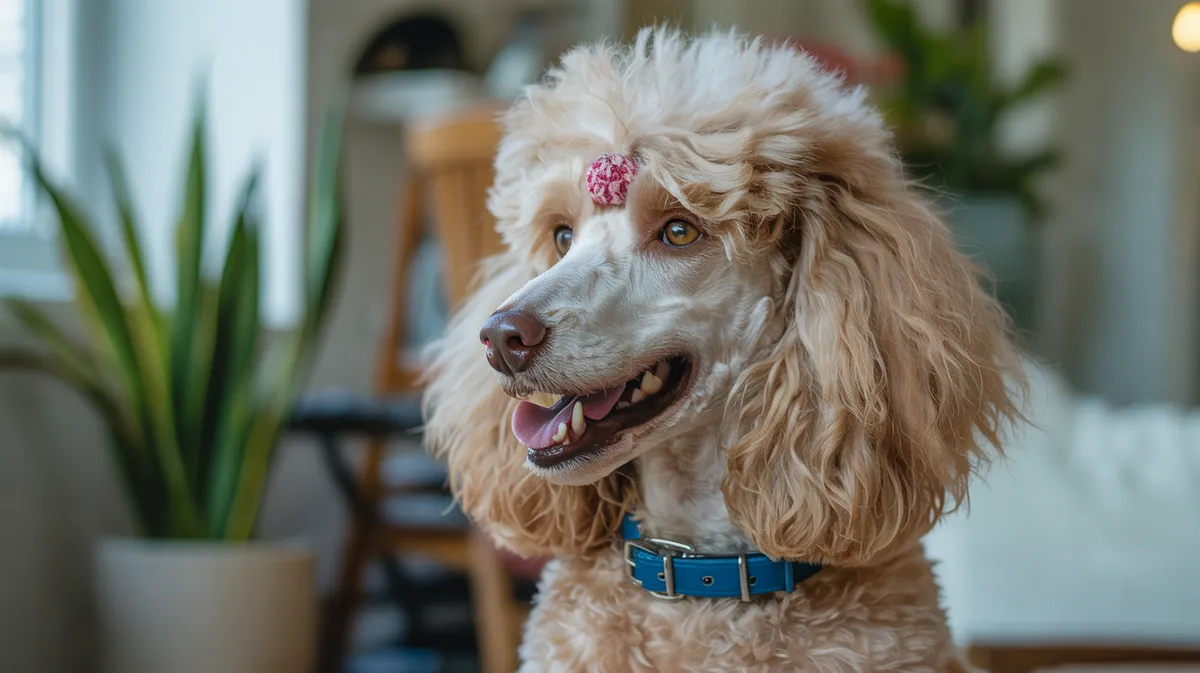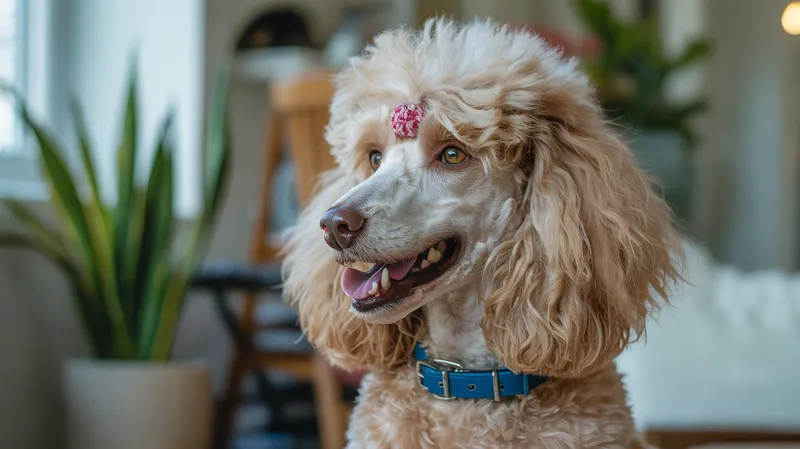
Poodle
Canis lupus familiaris

Meet the Poodle
The Poodle is a highly intelligent and versatile breed of domestic dog known for its curly, hypoallergenic coat and distinctive elegant appearance. Originally bred as a water retriever in Germany, Poodles come in three sizes: Standard, Miniature, and Toy, each sharing the same breed standard and characteristics. Highly trainable, Poodles excel in obedience, agility, and various canine sports, and are often chosen as service and therapy dogs. Their keen intelligence, friendly disposition, and low-shedding coat make them popular family pets worldwide. Poodles are also celebrated for their playful personalities and strong bonds with their human families.
Classification
Mammal
Habitat
Domestic environments, urban and suburban homes
Diet
Omnivore
Lifespan
12-15 years
Conservation
Least Concern
Weight
4–32 kg (9–70 lbs), depending on size variety
📖Fascinating Facts
Hypoallergenic Coats
Poodles have a curly, non-shedding coat that produces less dander, making them a popular choice for people with allergies.
Intelligence Champions
Ranked among the most intelligent dog breeds, Poodles are quick learners and excel in obedience and agility training.
Water Retrievers
Poodles were originally bred to retrieve waterfowl and are natural swimmers, with webbed feet aiding their movement in water.
📋Detailed Description
The Poodle (Canis lupus familiaris) is a highly distinctive breed of domestic dog, notable for its dense, curly, and often hypoallergenic coat, which serves as both insulation and protection in aquatic environments. Anatomically, Poodles possess a well-proportioned, athletic build with a straight back, deep chest, and long, muscular legs, contributing to their agility and stamina. Their skull is moderately rounded with a pronounced stop, and they have long, pendant ears covered in curly fur. Poodles are divided into four size varieties: Standard (45–62 cm at the withers, 20–32 kg), Medium (35–45 cm, 9–13 kg), Miniature (28–35 cm, 4.5–7 kg), and Toy (24–28 cm, 2–3 kg), though the Medium is not universally recognized. Behaviorally, Poodles are renowned for their intelligence, ranking among the most trainable of all dog breeds, and they exhibit a keen ability to learn complex tasks and commands. Socially, they form strong bonds with their human families and are often sociable with other dogs and pets. Their reproductive cycle is typical of domestic dogs, with estrus occurring twice annually and litters averaging 6–9 puppies, depending on size. Unique adaptations include their webbed feet, which enhance swimming ability, and a coat that can be clipped in various styles for functional or aesthetic purposes. Poodles are long-lived, with lifespans ranging from 10–18 years, and smaller varieties generally outliving larger ones. They are highly versatile, excelling in roles such as water retrieval, service and therapy work, and canine sports. Their adaptability and hypoallergenic qualities have also made them a popular choice for crossbreeding, resulting in numerous 'doodle' hybrids.
💡 Did you know?
Despite their strong association with France, Poodles were originally bred in Germany as water retrievers.
🔬Research & Sources
Wikipedia Summary
The Poodle, called the Pudel in German and the Caniche in French, is a breed of water dog. The breed is divided into four varieties based on size, the Standard Poodle, Medium Poodle, Miniature Poodle and Toy Poodle, although the Medium Poodle is not universally recognised. They have a distinctive thick, curly coat that comes in many colours and patterns, with only solid colours recognised by major breed registries. Poodles are active and intelligent, and are particularly able to learn from humans. Poodles tend to live 10–18 years, with smaller varieties tending to live longer than larger ones.
Last Modified: 6/3/2025
🎭Behavior & Social Structure
Poodles are highly active and require regular mental and physical stimulation to prevent boredom-related behaviors such as excessive barking or destructive chewing. Historically bred as water retrievers, they retain a strong instinct for fetching and carrying objects, and many display a love of swimming. Their intelligence makes them quick learners, and they respond well to positive reinforcement training methods. Socially, Poodles are affectionate and thrive on human companionship, often becoming deeply attached to their owners. They tend to be alert and responsive, making them effective watchdogs, though they are rarely aggressive. Poodles are generally friendly with children and other animals when properly socialized. Daily routines should include structured play, training sessions, and opportunities for exercise, with Standard Poodles requiring more vigorous activity than their smaller counterparts.
👶Reproduction & Life Cycle
Poodles reach sexual maturity between 6 and 12 months of age, with females typically coming into estrus twice a year. Mating is generally managed by breeders to ensure genetic health and avoid hereditary conditions. The gestation period averages 63 days. Litter size varies by variety: Standard Poodles may have 6–9 puppies per litter, Miniatures 4–6, and Toys 2–4. Poodles are attentive mothers, providing extensive care to their puppies, including nursing, grooming, and socialization. Puppies are born blind and deaf, with eyes and ears opening at around two weeks. Breeders often begin early neurological stimulation and socialization to foster well-adjusted adult dogs. Responsible breeding practices include genetic screening for common hereditary diseases such as hip dysplasia, progressive retinal atrophy, and certain skin conditions.
🛡️Adaptations & Survival
Poodles possess several adaptations that have contributed to their historical and modern success. Their dense, curly coat is water-resistant and provides thermal insulation, which was essential for their original role as water retrievers. The traditional 'continental' clip, with shaved hindquarters and pom-poms of fur left on the joints and chest, was designed to facilitate swimming while protecting vital organs and joints from cold water. Their webbed feet enhance swimming efficiency, and their long limbs contribute to a powerful, efficient gait. Behaviorally, their intelligence and eagerness to please have made them highly adaptable to a range of tasks, from hunting and retrieving to service and therapy work. Their low-shedding coat is also an adaptation that benefits allergy sufferers, making them suitable for a wider range of households.
📚Research Sources
🎨Cultural Significance
Poodles have played a prominent role in European culture since at least the 15th century, especially in France and Germany. They have been associated with aristocracy and elegance, frequently depicted in art, literature, and film. The breed is a national symbol of France, where it is known as the 'Caniche.' Poodles have also been used in circus performances due to their trainability and agility. In modern times, they are popular as companion animals and service dogs, and their image is often used in fashion and advertising to symbolize sophistication and intelligence. The rise of 'doodle' hybrids (e.g., Labradoodle, Goldendoodle) has further cemented their influence in contemporary canine culture.
🔬Recent Research & Discoveries
Recent genetic studies have explored the origins and diversity of the Poodle, confirming close genetic ties to other European water dog breeds. Ongoing research focuses on identifying and mitigating hereditary diseases through DNA testing, with particular attention to conditions such as progressive retinal atrophy and sebaceous adenitis. Studies on canine cognition consistently rank Poodles among the most intelligent breeds, with advanced problem-solving abilities and trainability. Research into hypoallergenic properties of Poodle coats has found that while they shed less dander than many breeds, individual allergic responses vary. The breed’s adaptability and temperament have made them a subject of interest in studies on canine-assisted therapy and emotional support.
🎥Wildlife Videos

Poodle Facts: 10 Interesting Things You Didn't Know
Did you know that Poodles were once war dogs? Or that Poodles were part of Ancient Greece? Here are the top 10 most ...
The Smart Canine

STORY OF THE POODLE | Documentary video with all details about POODLE
STORY OF THE POODLE | Documentary video with all details about POODLE The Poodle is a breed of dog that has a rich history ...
Animal stock

What NO ONE tells you about owning a Poodle
Looking to bring home a Poodle? There are things no one tells you about owning a Poodle that you should know before bringing ...
The Smart Canine

Episode 3 -Poodles in the Woods
Join me for a relaxed stroll though the forest with the poodles, looking for mushrooms and enjoying the peace.
Wyld in France

Rescue of a Toy Poodle Horribly Overrun by Parasites
Rescue of a Toy Poodle Horribly Overrun by Parasites. This is an AI-generated story, created with the purpose of raising ...
Rescue is me
🌍Habitat Information
The Poodle typically inhabits Domestic environments, urban and suburban homes environments. Poodles have adapted to their environments with specialized features and behaviors.
Primary Habitat:
Domestic environments, urban and suburban homes
More detailed habitat information will be available soon.
🛡️Conservation Status
The Poodle is currently classified as Least Concern. Conservation efforts are crucial for preserving this species for future generations.
Common Threats:
- 🏠Habitat loss and fragmentation
- 🌡️Climate change impacts
- 🎯Hunting and poaching
- 🏭Human-wildlife conflict
⚠️Threats & Conservation Challenges
As a domestic breed, Poodles are not threatened in the wild and have a stable global population. However, they face challenges related to overbreeding and the propagation of hereditary health conditions, particularly in popular varieties and designer crosses. Common health concerns include hip dysplasia, progressive retinal atrophy, Addison’s disease, and epilepsy. Unscrupulous breeding practices can exacerbate these issues. Additionally, Poodles may be surrendered to shelters due to behavioral problems stemming from inadequate exercise or training. Responsible ownership, ethical breeding, and ongoing health screening are essential to maintaining the breed’s health and well-being.
🔬Scientific Classification
Scientific Name
Canis lupus familiaris
Classification Hierarchy
🔍 About Taxonomic Classification
Taxonomic classification is a hierarchical system used by scientists to classify and organize living organisms based on shared characteristics and evolutionary relationships.
The system moves from broad categories (Kingdom) to increasingly specific ones, with each animal's scientific name typically consisting of its Genus and species.
📝Community Notes
Share your observations and insights about the Poodle with our community of wildlife enthusiasts.
Join Our Community
Sign in to share your observations and connect with fellow wildlife enthusiasts.
Sign In to ContributeNo community notes yet
Be the first to share your observations about the Poodle!
Explore Poodle
Select a tab above to learn more about this amazing animal.
📸Photo Gallery
No photos available for this animal yet.
🌟Discover More Wildlife
Continue your journey of discovery with more fascinating animals from our database
